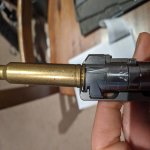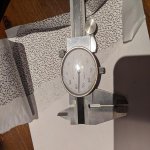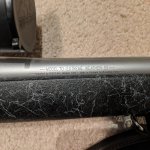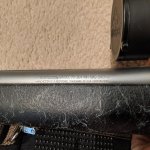I’m not a gunsmith or machinist, and I can't see the pictures posted last year, but I think I see what Mr. Leeper is talking about. I’ve attached pictures of a Portuguese-made Model 70 Extreme Weather bolt showing the gap between the extractor claw and the front of the groove on the cartridge case. I believe that he’s correct in that this results in a
slight loss of primary extraction. Specifically, during a few degrees of bolt lift - when the bolt is camming out of the locking recesses - the extractor is not engaging on the cartridge rim. This means that for that short amount of bolt lift, it’s just taking up slack before grabbing the case and pulling it out of the chamber.
I measured the distance from the bolt face to the extractor groove and I came up with about 0.050”. This matches Mr. Leeper’s math and his opinion that it’s machined 0.023” too close. Rearward bolt travel during primary extraction is about 0.120" (give or take), so roughly 17% of that potential camming effort is wasted taking up the gap.
As a comparison, I’ve also shown the bolt from a Swedish Mauser (the only other CRF reference that was handy). You’ll note that there’s not nearly the gap as there is on the M70.
I don’t think that this is a manufacturing defect. In my opinion, there’s too much engineering effort that goes into these for this to be a mistake. If I had to make an uneducated guess, the extra room under the extractor claw might be there to aid in feeding from the magazine. It would allow the cartridge to point up from the horizontal slightly and still slide smoothly under the claw as the bolt moves forward. Tightening things up a bit may introduce feeding issues.
Prior to reading this thread, I was unaware that this so-called ‘issue’ even existed. There’s nothing but praise for the FN South Carolina made guns, and the same remains true for the ones made in Portugal. In fact, having heard such great things about the FN/SC-made guns, I’d been looking for one for some time. I was quite excited when I saw a shipment come in at one of the site sponsors. I promptly bought one, picked it up a week later and brought it home. Imagine the crushing disappointment I felt when I looked at the marks on the barrel and realized that this thing was made in Portugal. I had no idea they’d moved production there.
Then I shot it, and all that buyer’s remorse evaporated.
This is a 0.4 MOA group (accounting for .308 projectile diameter) at 100 yards with factory ammo and a stock rifle. I consider myself only an ‘okay’ shot; certainly nothing above average.
The gun is fine: exceptionally well made, incredibly smooth, light weight and very accurate. There’s no one that owns one that’ll tell you different.



















































































